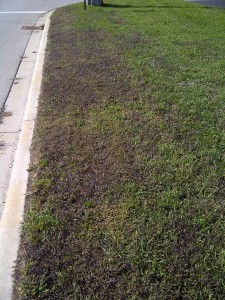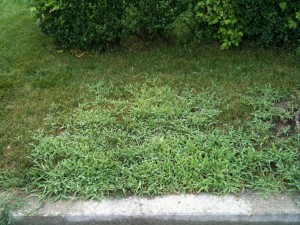Each and every year as the summer heat come on, and the drought follows, Crabgrass infestations thrive!
Crabgrass is an annual plant, which means it dies each year in the fall and then germinates again in the next year beginning in late spring and into summer.
The most common types of crabgrass found in home lawns are typically both smooth and hairy crabgrass species. Crabgrass typically becomes a major problem in home lawns beginning in late spring and throughout the summer months into the early fall. Infestations are common in areas of the lawn that are growing thinly, in areas where exposed soil exists, around and along the driveway and sidewalk edges, and in other weak areas of the lawn where the desired grass can be outcompeted due to under fertilization, poorly drained soils, and lack of water.
Crabgrass Infestation along curbside
Crabgrass plants grow very low to the ground and expand laterally in a circle upwards of 12 inches in diameter. As the plants grow bigger, and the infestation increases, the desired grass typically gets outcompeted quickly and the crabgrass completely takes over. A single crabgrass plant can produce over 150 000 seeds over the course of a season, and these seeds are what germinate come late spring the next year. knowing this, it is very important to re-establish desired turf back in these areas during the fall so the crabgrass has a much harder time finding its way back in the lawn the next season.

Crabgrass dying off turning purplish colour in the Fall
As the crabgrass plants begin to die off, the colour generally turns from lime coloured green to a purplish/yellowish/reddish colour. This discolouration indicates its time to begin a combination of cultural practices that can help with filling these infested areas back in with desired grass again. The fall is a great time for seeding and establishing new grass, and aggressively overseeding or slit-seeding these areas is recommended. Core aerating and topdressing these areas in conjunction with seeding will help speed up this re-establishment process even more.






